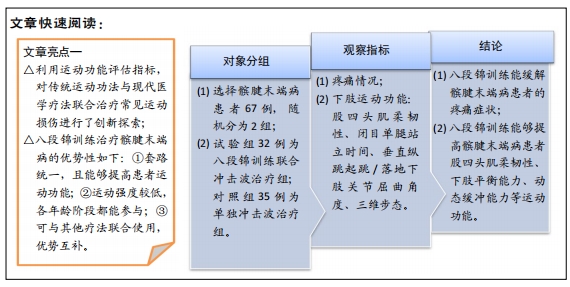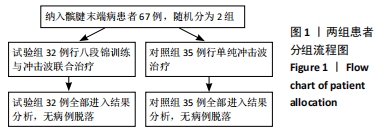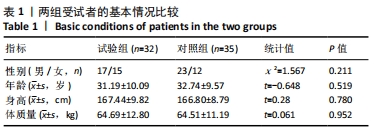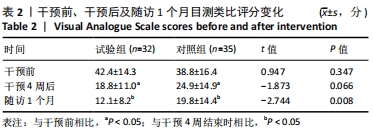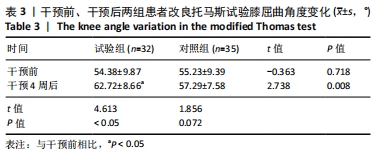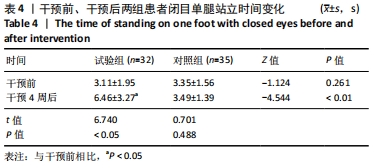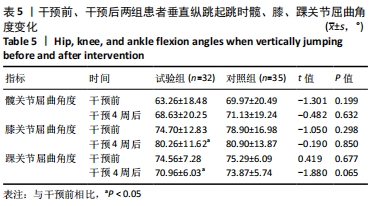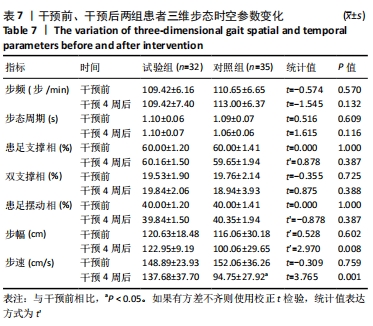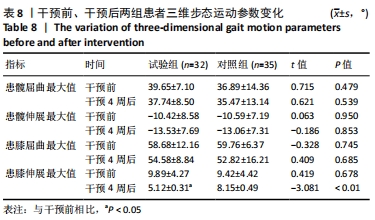[1] FERRETTI A, PAPANDREA P, CONTEDUCA F. Knee injuries in volleyball. Sports Med. 1990;10:132-138.
[2] 王国祥,张秋霞,鲍捷.髌腱末端病运动员膝关节动作反应的变化特征[J].中国康复医学杂志,2011,26(9):838-842.
[3] VISNES H, BAHR R. The evolution of eccentric training as treatment for patellar tendinopathy (jumper’s knee): a critical review of exercise programmes. Br J Sports Med. 2007;41(4):217-223.
[4] LIU ES, MARTINS JS, ZHANG W, et al. Molecular analysis of enthesopathy in a mouse model of hypophosphatemic rickets. Development. 2018; 145(15):dev163519.
[5] SMITH BE, HENDRICK P, BATEMAN M, et al. Study protocol: a mixed methods feasibility study for a loaded self-managed exercise programme for patellofemoral pain. Pilot Feasibility Stud. 2017;4:24.
[6] 黄梅,高淑清.温针灸结合离心训练治疗髌腱末端病的疗效观察[J]. 湖北中医杂志,2018,40(4):44-46.
[7] GRABCZYNSKI A, SZKLANNY K, WRZECIONO P. Applying EMG technology in medial and lateral elbow enthesopathy treatment using Myo motion controller. Australas Phys Eng Sci Med. 2019;42(3):701-710.
[8] 史姗姗,庞伟.离心运动训练在康复治疗中的应用进展[J].中国康复理论与实践,2018,24(2):173-178.
[9] 黄昌林,张建党,薛刚.训练模式对跟腱组织结构的影响及其意义[J].人民军医,2004,47(9):499-501.
[10] 晋松,冯媛,胡幼平.末端病非手术治疗的中西医研究概况[J].四川中医,2006,24(12):39-41.
[11] MASLOV LN, PODOKSENOV AI, KHALIULIN IG. The Phenomenon of Ischemic Postconditioning of the Heart. Angiol Sosud Khir. 2017;23(1): 21-28.
[12] SHIMIZU S, SAITO M, DIMITRIADIS F, et al. Protective effect of ischaemic post-conditioning on ipsi-lateral and contralateral testes after unilateral testicular ischaemia-reperfusion injury. Int J Androl. 2011;34(3):268-275.
[13] WANG CJ, WANG FS, KUENDER D, et al. The effect of shock wave treatment at the tendon–bone interface an histomorphological and biomechanical study in rabbits. J Orthop Res. 2004;23(2):274-280.
[14] WANG CJ, HUANG HY, PAI CH. Shock wave-enhanced neovascularization at the tendon-bone junction: an experiment in dogs. J Foot Ankle Surg. 2002;41(1):16-22.
[15] WONG MW, QIN L, TAI JK, et al. Engineered allogeneic chondrocyte pellet for reconstruction of fibrocartilage zone at bone-tendon junction--a preliminary histological observation. J Biomed Mater Res B Appl Biomater. 2004;70(2):362-367.
[16] ALSHIHRI A, KÄMMERER PW, HEIMES D, et al. Extracorporeal Shock Wave Stimulates Angiogenesis and Collagen Production in Facial Soft Tissue. J Surg Res. 2020;245:483-491.
[17] 林伟龙,林勇,蓝芳.舒经活血洗方熏蒸联合体外冲击波治疗早中期钙化性冈上肌腱炎临床观察[J].浙江中西医结合杂志,2018, 28(10):867-869.
[18] 陈芳.“健康中国”视角下马王堆导引术养身之道研究[J].武术研究, 2019,4(10):92-94.
[19] 袁春香.八段锦锻炼对预防老年人跌倒的研究[J].临床医药文献电子杂志,2017,4(35):6929-6930.
[20] 杨慧馨,刘晓蕾.太极拳和八段锦对脑卒中患者偏瘫下肢运动功能和表面肌电的效果[J].中国康复理论与实践,2019,25(1):101-106.
[21] 曹青青,朱诗话,郝锋,等.健身气功防治中老年人原发性骨质疏松症的Meta分析[J].中国医药导报,2018,15(30):131-136.
[22] 黄敏玲,卢伟焰,梁桂兴,等.呼吸八段锦功法创制概述[J].新中医, 2019,51(11):302-304.
[23] 韩娟娟,张新安.八段锦对脑外伤康复期患者认知功能和负性情绪的疗效[J].中国康复理论与实践,2019,25(9):1084-1088.
[24] 赵晓东,魏慧军,杨承芝,等.健身气功八段锦在失眠治疗中的作用及机制探讨[J].世界睡眠医学杂志,2019,6(9):1213-1215.
[25] 曾令烽,杨伟毅,郭达,等.传统运动疗法干预对膝骨关节炎患者疼痛改善及关节功能影响的系统评价[J].中华中医药杂志,2018, 33(5):2132-2139.
[26] 李中锋,邓强,张彦军,等.八段锦改善老年骨质疏松患者平衡能力及跌倒风险的疗效观察[J].西部中医药,2019,32(9):62-65.
[27] 李小燕,云洁,何杰,等.八段锦对骨质疏松症患者干预效果的Meta分析[J].中国骨质疏松杂志,2019,26(1): 37-43,84.
[28] 高嘉良,陈光,李海霞,等.以太极拳为主的中医传统运动在心脏康复中的作用[J].中医杂志,2021,62(3):199-204.
[29] 陈李圳,景向红,代金刚.太极拳和八段锦缓解慢性疼痛机制的研究进展[J].中医杂志,2021,62(2):173-178.
[30] 朱云芳,吴传莉,杨雅红,等.温针灸联合八段锦治疗非酒精性脂肪肝病疗效观察[J].上海针灸杂志,2020,39(12):1525-1529.
[31] 于长隆,曲绵域.实用运动医学[M].北京:北京大学医学出版社, 2003:482-483.
[32] 王前源,刘水涛,卫小春,等.体外冲击波疗法治疗肩袖钙化性肌腱炎的荟萃分析[J].中国医学前沿杂志(电子版),2017,9(2):1-6+173.
[33] 尹晓震.体外冲击波配合体能康复训练对辽宁优秀田径运动员髌腱末端病治疗研究[D].大连:辽宁师范大学, 2014.
[34] 文江.离心训练与PNF拉伸训练股四头肌对髌腱末端病的疗效观察[D].成都:成都体育学院,2018.
[35] 王伟.针灸联合冲击波治疗髌腱末端病[J].世界最新医学信息文摘, 2018,18(37):143.
[36] MATTAP SM, AITKEN D, WILLS K, et al. Patellar tendon enthesis abnormalities and their association with knee pain and structural abnormalities in older adults. Osteoarthritis Cartilage. 2019;27(3): 449-458.
[37] PANNI AS, BIEDERT RM, MAFFULLI N, et al. Overuse injuries of the extensor mechanism in athletes. Clinics Sports Med. 2002;21(3): 483-498.
[38] FUKUDA TY, ROSSETTO FM, MAGALHÃES E, et al. Short-term effects of hip abductors and lateral rotators strengthening in females with patellofemoral pain syndrome: a randomized controlled clinical trial. J Orthop Sports Phys Ther. 2010;40(11):736-742.
[39] 安丙辰,郑洁皎,周甜甜,等.髋关节肌训练治疗膝骨关节炎的短期效果[J].中国康复理论与实践,2021,27(2):203-207.
[40] 苏艳红,张世超,金喜桢.“健身气功·八段锦”对女大学生最大等长肌力及平衡能力的影响[J].辽宁师范大学学报(自然科学版), 2018,41(3):422-427.
[41] 江岩,来章琦,范恺怡,等.12周健身气功八段锦对膝骨关节炎患者下肢体成分及肌肉厚度影响[J].辽宁中医药大学学报,2020, 22(8):90-93.
[42] 齐立卿,杜景华,王金榜.养元柔肝法治疗膝骨关节炎64例[J].四川中医,2009,27(3): 92-93.
[43] 陈志煌,韦嵩,沈鹰,等. 横络解结法治疗活动期类风湿关节炎的临床疗效评价[J].中国临床保健杂志,2011,14(2):123-126.
[44] 朱中书,刘方铭. 《灵枢》“解结”理论浅谈[J].中国针灸,2014, 34(11):1087-1088.
[45] 张丽芬. 八段锦对老年人平衡能力影响的研究[D].北京:首都体育学院,2012.
[46] 都文渊,赵玉斌,姚建景,等.八段锦对老年人平衡功能影响的Meta分析[J].临床医学研究与实践,2020,5(16):1-4.
[47] SEELEY MK, PARK J, KING D, et al. A Novel Experimental Knee-Pain Model Affects Perceived Pain and Movement Biomechanics. J Athl Train. 2013;48(3):337-345.
[48] ZOU L, SASAKI JE, WANG H, et al. A Systematic Review and Meta-Analysis Baduanjin Qigong for Health Benefits: Randomized Controlled Trials. Evid Based Complement Alternat Med. 2017;2017:4548706.
[49] 付啸. 八段锦对老年人下肢平衡稳定性影响的研究[D].济南:山东体育学院,2020.
[50] 陈瑶,俞泳,何成奇.膝骨关节炎患者本体感觉、肌力及关节功能的相关性研究[J]. 四川大学学报(医学版),2015,46(6):880-884.
[51] 刘汉良,尤春景,黄晓琳,等.正常人动态平衡能力测试的信度及效度分析[J].中华物理医学与康复杂志,2004,26(3):152-155.
[52] 冯茹. 髌腱末端病自愈的生物力学因素的队列研究[D].北京:北京体育大学,2015.
[53] MARKOLF KL, O’NEILL G, JACKSON SR, et al. Effects of applied quadriceps and hamstrings muscle loads on forces in the anterior and posterior cruciate ligaments. Am J Sports Med. 2004;32(5):1144-1149.
[54] SHIMOKOCHI Y, AMBERAONKAR JP, MEYER EG, et al. Changing sagittal plane body position during single-leg landings influences the risk of non-contact anterior cruciate ligament injury. Knee Surg Sports Traumatol Arthrosc. 2013;21(4):888-897.
[55] 卢迪. “跳跃膝”对排球运动员跳跃动作的影响[D].北京:北京体育大学,2012.
[56] NHA KW, PAPANNAGARI R, GILL TJ, et al. In vivo patellar tracking: Clinical motions and patellofemoral indices. J Orthop Res. 2008;26(8): 1067-1074.
[57] 蒋黎明,陶莹,于小明,等.髌骨运动轨迹异常导致膝骨关节炎的病因机制及治疗研究进展[J].中国康复,2020,35(11):605-608.
[58] 张琦.髌股关节疼痛综合征患者的疼痛治疗[J].中国康复理论与实践,2007, 13(3):267-269.
[59] 刘万林,魏慧,怀娟,等.半蹲训练改善脑卒中患者膝过伸的疗效观察[J].中国康复,2011,26(1):18-19.
[60] 黄萍, 钟慧敏, 陈博,等. 正常青年人三维步态:时空及运动学和运动力学参数分析[J]. 中国组织工程研究,2015,19(24):3882-3888.
[61] PEERY J, BURNFIELD JM. Gait Analysis: Normal and Pathological Function. Slack. 2010.
[62] 郭晓芬,李长辉,林斌强,等. 基于步态分析探讨膝骨性关节炎的治疗方向[J]. 中医临床研究,2020,12(34):138-141.
[63] 黄灵燕.太极拳干预对老年膝骨关节炎患者临床康复效果及步态生物力学的影响[D].上海:上海体育学院,2015.
[64] RASMUSSEN LJH, CASPI A, AMBLER A, et al. Association of neurocognitive and physical function with gait speed in midlife. JAMA Netw Open. 2019;2(10):e1913123.
|
